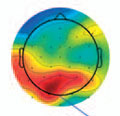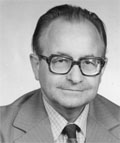The eLitMed.hu medical portal uses computer cookies for convenient operation. Detailed information can be found in the Cookie-policy.
Clinical Neuroscience - 2008;61(09-10)
Content
[Synchronized, oscillatory brain activity in visual perception]
[The present study investigates one of the most promising developments of the brain-mind question, namely the possible links between synchronized oscillatory brain activity and certain (visual) perceptual processes. Through a review of the relevant literature, the author introduces the reader to the most important theories of coherent perception (’binding‘), and makes an attempt to show how synchronization of EEG-registrable oscillatory activities from various frequency bands might explain binding. Finally, a number of clinical problems are also mentioned, regarding which the presented theoretical framework might deserve further consideration.]
[Antiepileptic drugs as mood stabilizers: what did we learn from the epileptology?]
[Author summarizes the practical aspects of psychiatric application of mood stabilizing antiepileptic drugs. He observes how to transfer experiences taken from the “epileptological” practice into the psychiatric care of bipolar patients. He shortly demonstrates the relevant information on the mechanisms of action, controversies and possible clinical effects influenced by the seizure inhibiting effect of the concerning molecules. By the opinion of the author the clinical importance of pharmacokinetic parameters are underestimated in the psychiatric practice. Therefore - as an original approach in the literature - he summarizes the detailed clinical indications of serum level measurements of antiepileptic drugs applied in psychiatry as mood stabilizers. The therapeutic experiences in epilepsy added a lot of practices for the most effective dosing, building, tapering and exchange of the mood stabilizer antiepileptics. Drug interactions (appear among the psychotropic drugs or with the commonly used medicines). As in any chronic therapies the main condition of patient's compliance is the lacking or very mild presence of the applied therapy. The paper discusses the most frequently occurring and drug-specific side effects in table forms. Using the term of “relative therapeutic potential” the need of balance between the efficacy (influenced by the choice and dosing) and the tolerance are pointed. Rules of application can change significantly in special populations like in pregnancy, obesity, chronic diseases or in chronic comorbide states and in case of polytherapy. As for the special therapeutic effects, the experiences are not completed even in group of antiepileptics: we have larger and more favorable knowledge on the traditional drugs (carbamazepine and valproates) and on lamotrigine (from the newer generation) but promising but not enough information exists on the newest antiepileptic molecules. Further targeted studies are needed for the identification and positioning of antiepileptic drugs in the palette of mood stabilizing pharmacotherapy and for the definition of evidence based, individually tailored and lifelong applied highly effective combinations of the mood stabilizing pharmacotherapy containing antiepileptic agents.]
[The impact of prolonged hunger strike: clinical and laboratory aspects of twenty-five hunger strikers]
[Background - Hunger strike is a very serious entity which may lead to severe diseases and death. Aims - The aim of this study is to document the clinical, neurophysiological, neuroradiological, and neuropsychological aspects of prolonged hunger strike. Material and method - We investigated the clinical and laboratory characteristics of 25 hungerstrikers hospitalized during refeeding process. One sample t-test, independent samples t-test, Mann-Whitney and Pearson correlation tests were used for statistical analyses. Results - Twelve of them had a continuous hunger strike ranging between 190-366 days. The other 13 had quitting intervals for various reasons with a continuous hunger ranging between 65-265 days with a total hunger duration of 153-382 days. The mean loss of body mass index (BMI) was 40.98±9.3%. Imbalance, sleep disorders, somatosensory disturbances, and adynamia were the most common complaints. At admission, one third experienced ophtalmoparesis, about half of them had paresis, one quarter had truncal ataxia. At discharge 16% had persistant ophtalmoparesis and 36% nystagmus. Only four patients (16%) could walk independently. There was no serious MRI, EEG findings. Most prominent EMG findings were the decrease in median and sural nerve cnap, median and fibulary cmap, and fibulary ncv values. They showed mild impairment in MMTS and most of them had attention deficit and frontal type memory impairment. Conclusion - It can be concluded that vitamin B intake, independent of the quantity and timing, lowers the morbidity and mortality of hunger strikers.]
[Paraneoplastic chronic demyelinating neuropathy and lambert-eaton myasthenic syndrome associated with multiple anti-neural antibodies and small-cell lung cancer]
[Lambert-Eaton myasthenic syndrome (LEMS) developed in a patient with presumed chronic inflammatory demyelinating polyneuropathy (CIDP) and negative chest CT. Since antibodies against both Hu and voltage-gated calcium channel (VGCC) were detected, repeated chest CT was performed, which eventually showed a pulmonary mass lesion. Biopsy revealed small cell lung cancer (SCLC) indicating the importance of repeated chest CT in LEMS even when an existing autoimmune-like disease and negative CT may suggest an autoimmune origin. This is the first report of paraneoplastic CIDP and LEMS associated with anti-Hu, anti-VGCC and SCLC.]
[Abstracts of the 4th Pannonian Symposium on CNS Injury]
[Abstracts of the 4th Pannonian Symposium on CNS Injury 2008;61(09-10)]
[European Association of Young Neurologists and Trainees]
[European Association of Young Neurologists and Trainees 2008;61(09-10)]
1.
Clinical Neuroscience
[Headache registry in Szeged: Experiences regarding to migraine patients]2.
Clinical Neuroscience
[The new target population of stroke awareness campaign: Kindergarten students ]3.
Clinical Neuroscience
Is there any difference in mortality rates of atrial fibrillation detected before or after ischemic stroke?4.
Clinical Neuroscience
Factors influencing the level of stigma in Parkinson’s disease in western Turkey5.
Clinical Neuroscience
[The effects of demographic and clinical factors on the severity of poststroke aphasia]1.
2.
Clinical Oncology
[Pancreatic cancer: ESMO Clinical Practice Guideline for diagnosis, treatment and follow-up]3.
Clinical Oncology
[Pharmacovigilance landscape – Lessons from the past and opportunities for future]4.
5.













